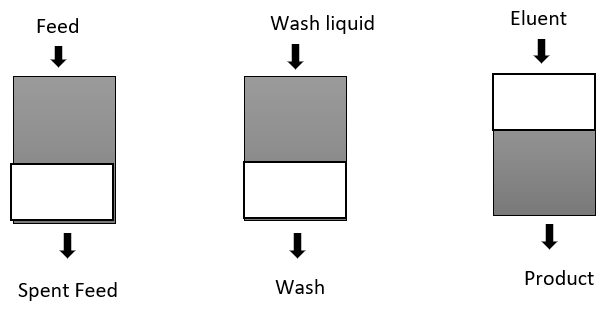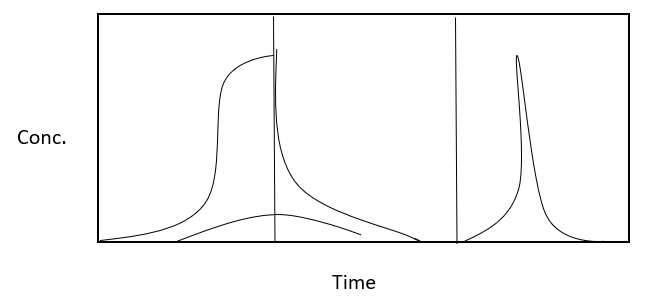This set of Bioseparation Science Multiple Choice Questions & Answers (MCQs) focuses on “Packed Bed Adsorption”.
1. The particulate material of adsorbent is used frequently in the form of ___________
a) batch adsorption
b) fed batch adsorption
c) packed bed adsorption
d) airlift adsorption
View Answer
Explanation: The particulate material of adsorbent is frequently used in the form of a porous packed bed within a column which is cylindrical in shape. The column keeps the adsorbent in one place and facilitates its reuse.
2. Why the column holds the adsorbent at place and helps in the reuse?
a) To avoid separation step
b) To avoid adsorption
c) To facilitate separation step
d) To facilitate adsorption
View Answer
Explanation: The column holds the adsorbent in place so that, the separation steps of solid or liquid required in adsorption process with suspended adsorbents is avoided and the feed solution is passed through the packed bed for selective adsorption of the target molecule.
3. What is the significance of the given diagram?

a) Batch adsorption
b) Packed bed adsorption
c) Fed batch adsorption
d) Continuous adsorption
View Answer
Explanation: The diagram explains the passing of feed solution through the packed bed for selective adsorption of the target molecule and the feed is pumped into the packed bed to the point where flow-rate and the pressure requirements are not too critical and the flow of feed due to gravity could be used.
4. The effluent stream from packed bed is monitored for the ___________
a) adsorbent
b) adsorbate
c) impurities
d) target molecule and impurities
View Answer
Explanation: The exit or effluent stream within the packed bed can be monitored for both the target molecules as well as the impurities present in the bed for the process of adsorption in the bioseparation engineering.
5. The adsorption process using packed bed is __________
a) linear
b) cyclic
c) both linear and cyclic
d) zig zag
View Answer
Explanation: The adsorption process using a packed bed is cyclic in nature out of which the first step of the process is the adsorption step and it involves the pumping of a predetermined amount of feed solution through the packed bed and the second step is the washing step.
6. The impurities are removed in the washing steps.
a) False
b) True
View Answer
Explanation: The impurities are removed along with the effluents in the first step which is referred as adsorption step.
7. The impurities in the void space are removed by __________
a) solid
b) liquid
c) gas
d) semi solid
View Answer
Explanation: The remaining impurities in the void areas of packed bed will be removed by passing liquid to the bed through washing step, mainly the liquid which is used as feed is used for the washing process.
8. Which is the last step of the process in packed bed adsorption?
a) Adsorption
b) Washing
c) Elution
d) Packing
View Answer
Explanation: The last step of the process in packed bed adsorption is the elution step and it is carried out by pumping through the packed bed, a liquid which facilitates desorption of the target molecule.
9. The sequence of the event in packed bed adsorption can be observed by __________
a) composition of effluent stream
b) type of wash liquid
c) type of feed
d) type of product
View Answer
Explanation: The sequence of the event in packed bed adsorption can be observed by the monitoring of the composition of the effluent stream based on the steps of adsorption, washing and finally the effluent step of the packed bed adsorption process in bioseparation engineering.
10. The feed solution in the packed bed is pumped until __________
a) target molecule disappears
b) effluent is lost
c) target molecule appears in the effluent
d) impurities are visible
View Answer
Explanation: The feed solution is pumped in packed bed till the time taken by the target molecule to start disappearing into the effluent and then it lasts into pump in more feed and leads to loss of the target molecule.
11. Why at initial stage of packed bed adsorption process, the effluent is freed from target molecule?
a) Due to washing
b) Due to adsorption
c) Due to elution
d) Due to impurities
View Answer
Explanation: Due to the adsorption as the initial stages of a packed bed adsorption process, the effluent gets free from the target molecule and the solution in feed is pumped through the packed bed until the target molecule is seen in the effluent.
12. What is referred to as user defined concentration in the packed bed adsorption?
a) Break through concentration
b) Break out concentration
c) Break in concentration
d) Breakthrough solution
View Answer
Explanation: The user-defined concentration is termed as the breakthrough concentration and the time at which breakthrough occurs is called the breakthrough time. If feed solution were pumped through the packed bed beyond the breakthrough time, the adsorbent particles would get increasingly saturated. The target molecule concentration in the effluent stream would begin to rise, slowly at first and then very rapidly and eventually becomes the same as that in the feed solution.
13. What is the significance of the given diagram?

a) Composition profile
b) Packed bed adsorption
c) Effluent
d) Effluent composition profile in packed bed adsorption
View Answer
Explanation: The given diagram is a plot of the concentration of the target molecule in the effluent stream which specifies the function of time in terms of user defined concentration plot of effluent profile.
Sanfoundry Global Education & Learning Series – Bioseparation Science.
To practice all areas of Bioseparation Science, here is complete set of 1000+ Multiple Choice Questions and Answers.
If you find a mistake in question / option / answer, kindly take a screenshot and email to [email protected]
